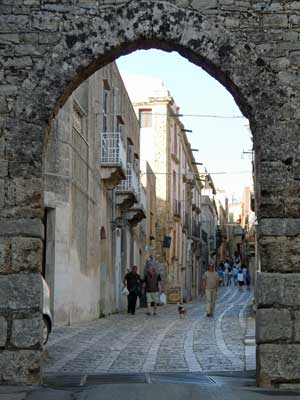Erice is a memorable medieval hilltown with ancient origins in Sicily, close to the port city of Trapani on the island’s western coast. The sober historic town is surrounded by defensive town walls, crowned by a castle, and dominates the surrounding area from its mountainous height of approximately 800 metres above sea level. Erice is pronounced with the stress on the first syllable: EH-richay.
- Sicily destinations and practicalities: full menu (at foot of this page)
About Erice
Erice is in such a spectacular, naturally fortified position high above the natural harbour of Trapani, that it is not surprising that the site has been occupied for millennia. It’s perhaps not suprising either, that with the crag’s veil of shifting clouds and air of mystery it was an important sacred site. There was a temple of Venus here which outlasted the different civilisions holding sway in the area. The female divinity to which the shrine was dedicated changed slightly with each culture: Astarte for the Phoenicians, Aphrodite for the Greeks and Venus for the Romans. Fertility rites would probably have taken place on or around the temple site, at the highest point of the town.
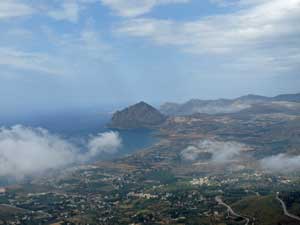
Erice was probably founded by the Elymians, a native Sicilian people who also built the nearby town and temple of Segesta. After the Greeks, Carthaginians and Romans, the town was later ruled by the Arab, then the Norman rulers of Sicily. For the Arabs it was Gebel-Hamed, for the Normans and their successors Monte San Giuliano, then in the 1930s the town became one of several in Italy to be renamed under Mussolini in honour of its ancient past, and Monte San Giuliano, formerly Eryx, became Erice. Nowadays as well as Catholic churches there are also monuments to new gods on the heights of Erice: gigantic communications masts.
Visiting Erice
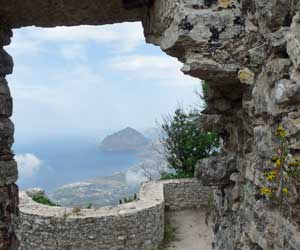
Erice is basically triangular in shape, with steep lanes leading up and around from the Porta Trapani gateway, where you’ll find the cable-car station (more below on transport). This is at one point of the triangle, with the main street, Vittorio Emanuele, leading straight uphill towards the town’s principal square, Piazza Umberto I.
However, the most tempting way to begin is to follow the town walls from Porta Trapani around to the right to reach the Castello di Venere (Castle of Venus), at the wild back of the crags; the furthest point of the triangle. In front is a shady park, the Giardino del Balio, dotted with stone busts. There are good views from here, and a cafe with a nice panoramic terrace.
The twelfth-century Castello di Venere is on the site of Erice’s ancient temple. It’s open daily, with a small admission charge. Through a gateway and up a flight of stairs, visitors emerge into an open walled space built onto the bare rock. Signs and a guide-map indicate the traces of the different stages of the site’s history, but the most compelling sight is actually the stupendous view from the fortifications. You can see the sea, the coastline and the crags along with some of Erice’s other ruined fortifications, including the fairy-tale Toretta Pepoli, a small ‘castle’ built onto the rocks.
Alternatively heading through Porta Trapani and up Corso Vittorio Emanuele you come almost at once to Erice’s principal church, the Chiesa Madre or Real Duomo. The attractive building dates to the fourteenth century, when it was constructed using materials from the ancient Temple of Venus. The church has a surprising and appealing nineteenth-century neo-gothic interior.
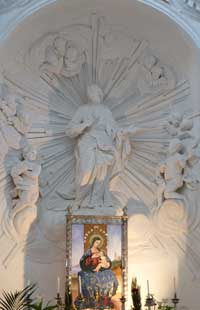
Erice has a remarkable number of churches, many of which are interesting enough to visit. There is a combined ticket available for a selection of these sights, which are kept open for tourists – an admirable initiative which helps with the costs of upkeep. The combined ticket includes the bell-tower adjacent to the Chiesa Madre, a campanile which is known as the Torre di Re Federico Secondo after the king who built it. This is a steep climb with many steps, but the view is good.
Other particularly interesting churches include the attractive Chiesa di San Giuliano, home to a charming painted wood statue of San Giuliano, and the Chiesa di San Martino, a church complex with eighteenth and nineteenth-century paintings, more painted wood sculptures and a crypt. This religious site belonged to the Congregazione del Purgatorio – look out for the carvings of Purgatory over the church’s external portal, depicting a nude torso being consumed by flames – you’ll see similar images around Sicily
The best place to rest after climbing around Erice’s steep streets is in Piazza Umberto I, the hub of the small town. This steeply-sloping little square makes a lively central spot to relax at a cafe table or to get your bearings after explorations. If you want to learn more about Erice, there is a small town museum here (with limited opening hours).
Practicalities
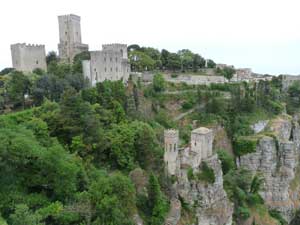
Erice is famous for its almond biscuits and pastries, proudly stacked up in the windows of several pasticcerie. There are also plenty of snack and souvenir shops aimed at the tourists who arrive each day to explore the medieval lanes. The best places to enjoy a sit-down and a drink are the cafe-bars in Piazza Umberto, and the panoramic cafe in the park by the Castello di Venere. There are public toilets just downhill from the piazza (signposted ‘gabinetti pubblici‘).
Erice is often lost in swirls of mist and cloud, so a view isn’t guaranteed. Locally these clouds are called “kisses of Venus” – a notion whose romance perhaps goes some way to compensating for the lost panorama. The town does get visited by coach parties, but these can be avoided by heading off down side streets and exploring the winding little lanes away from the main shops, or by lingering into the evening. It’s good to allow plenty of time to explore the maze of streets. A map is useful, as the geography can confuse visitors, but Erice is small enough that you won’t be lost for long.
Erice is a pretty town, in a sombre, grey kind of way, and it is very atmospheric. Unusually for Sicily, its historical centre is largely intact, clean and well-kept. Its streets are handsomely paved with a characteristic pattern of differently-sized shiny stones. Only about 300 people now live in the historic centre, though there are other settlements around the slopes below. The town is busy in summer though, and on Good Friday, when Erice’s wooden sculptures of the misteri – crucifixion scenes – are carried around town in a solemn Easter procession.
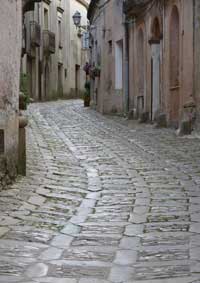
Around Erice
If you have a car, Erice can be combined in a day trip with the temple site at Segesta. Trapani is the biggest town in the area and worth visiting even if you aren’t using it as a base. For a touring holiday in this part of Sicily, Erice fits in well with Trapani, Marsala, Castellammare del Golfo, Segesta, the beach resort of San Vito lo Capo and the Egadi Islands.
Erice travel and transport
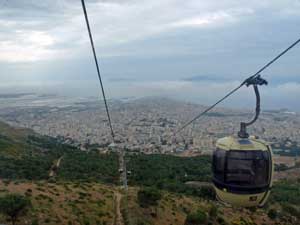
The most exciting way to get to Erice is by taking the cable-car (funivia) which climbs from the outskirts of Trapani to the town wall of Erice, its station just outside Porta Trapani, the gateway into the old town. The ten-minute journey is wonderfully panoramic, with views back over Trapani, the sea and the Egadi Islands. The funivia runs every day from morning to night, except Mondays when it generally opens only at 2pm. You can check the latest times and ticket prices on the funivia website (see links below).
Inconveniently, the Trapani cable-car station is about three miles from central Trapani, on Via Capua, just off a long street (variously named Via Fardella, Corso Mattarella, Via Manzoni) which heads all the way from the edge of the historic centre to the slopes below Erice. There are urban buses which connect the town centre with the cable-car (when I wrote this, the best way was to buy tickets then catch the one of the appropriate buses, including 21 and 23, from Piazza Vittorio Emanuele), though note that you should check their timetables too; we ended up stranded on a Sunday a few years back. Timetables for local Trapani bus services can be seen on the website of ATM (link below) – look for ‘Funivia’ on the timetables. Several services appear to link the port and cable-car at the time of writing. I’d recommend asking locally for advice when making your plans if you’ll be relying on public transport
There are also a few buses a day from Trapani up to Erice operated by AST, – check the timetable in advance. The bus journey takes around 45 minutes. On Sundays and public holidays there are fewer services.
There is car parking outside the town wall by Porta Trapani, and a car park by the funivia station in Trapani, if you prefer to leave your car below and enjoy the panoramic cable-car ride up to Erice.
Erice accommodation
Hotels and B&Bs
You can easily visit Erice in a day, or half a day, from Trapani. But if you want the romantic experience of staying in this lofty town after dark, there are some decent and affordable places to stay in the medieval town centre. Good choices include the excellent family-run three-star Hotel San Domenico, the simple, atmospheric old monastery of Il Carmine and Hotel Elimo, another good, central three-star, which has views down towards the coast.
> Find a hotel or B&B in Erice
![]()
Highlights
Combine Erice with
If you like Erice, you may like
Viterbo, Lazio
Useful external links
ATM buses – Trapani urban services
